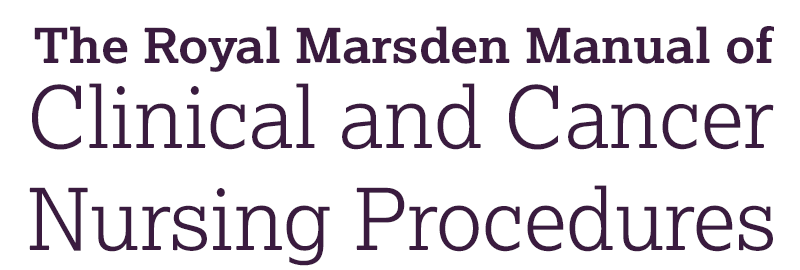You are viewing a javascript disabled version of the site. Please enable JavaScript for this site to function properly.
Go to headerGo to navigationGo to searchGo to contentsGo to footer
Go to chapter navigation

Figure 15.1
A patient‐centred approach.

Figure 15.5
Examples of oral medication.

Figure 15.9
Dosette box.

Figure 15.13
Metered dose inhaler (MDI).

Figure 15.17
How to instil eye drops.

Figure 15.21
Ampoules.

Figure 15.25
Safety needles.

Figure 15.29
Intramuscular injection sites. Source : Adapted from Rodger and King ( ) with permission of John Wiley & Sons.

Figure 15.33
Blood administration set.

Figure 15.37
Patient‐controlled analgesia (PCA) pump, generally used in acute hospital settings.

Figure 15.41
Extravasation.

Figure 8
Holding the ear for ear drops.

Figure 10
A CME Medical (previously McKinley) T34 syringe pump.

Figure 17
Remove the needle cap. Source : Reproduced with permission of Teleflex Group UK, Ltd.

Figure 15.2
Self‐administration nursing assessment chart. Source : The Royal Marsden NHS Foundation Trust.

Figure 15.6
Medicine pot.

Figure 15.10
Oral syringe (compliant with NHS Improvement guidance).

Figure 15.14
Accuhaler.

Figure 15.18
How to instil eye ointment.

Figure 15.22
Vials.

Figure 15.26
Lumbar puncture needles and intrathecal syringe.

Figure 15.30
Fluid administration set.

Figure 15.34
Extension set with needle‐free injection cap.

Figure 15.38
Epidural pump.

Figure 15.42
Flowchart for the management of extravasation.

Figure 5
Suggested method of vial reconstitution to avoid environmental exposure. (a) When reconstituting the vial, insert a second needle to allow air to esca...

Figure 3
Select needle size. Source : Reproduced with permission of Teleflex Group UK, Ltd.

Figure 19
Insert the needle. Source : Reproduced with permission of Teleflex Group UK, Ltd.

Figure 15.3
An example of recording the receipt from pharmacy and the supply to a patient of controlled drugs in a controlled drugs register.

Figure 15.7
Tablet splitter.

Figure 15.11
Transdermal patches.

Figure 15.15
Turbohaler.

Figure 15.19
Effects of mydriatics.

Figure 15.23
Syringes: Luer‐Lok (far left and far right) and Luer‐Slip (middle three).

Figure 15.27
Ommaya reservoir.

Figure 15.31
Roller clamp.

Figure 15.35
Volumetric pump.

Figure 15.39
Elastomeric device.

Figure 15.43
Vascular access device decision tool. CVA, cerebrovascular accident; CVAD, central venous access device; IV, intravenous; LMW, low molecular weight; S...

Figure 6
Method to minimize coring.

Figure 12
Palpate the site to locate anatomical landmarks. Source : Reproduced with permission of Teleflex Group UK, Ltd.

Figure 24
Remove the stylet. Source : Reproduced with permission of Teleflex Group UK, Ltd.

Figure 15.4
An example of the incorrect recording of the receipt of a supply of controlled drugs from pharmacy in a controlled drugs register.

Figure 15.8
Tablet crusher.

Figure 15.12
Nebulizer.

Figure 15.16
Spacer device.

Figure 15.20
Effect of miotics.

Figure 15.24
Needles.

Figure 15.28
Sites recommended for subcutaneous injection. Source : Adapted from Perry et al. ( ) with permission of Elsevier.

Figure 15.32
Labelled administration set.

Figure 15.36
Syringe pump.

Figure 15.40
Decision tree for selection of an infusion device. Source : Adapted from MHRA ( ). © Crown copyright. Reproduced under the Open Government Licence v2...

Figure 15.44
Monoclonal antibodies risk assessment form. Source : adapted from Langford et al. ( ).

Figure 13
Intradermal bleb. Source : Adapted from Springhouse ( ) with permission of Wolters Kluwer.

Figure 15
Clean the site. Source : Reproduced with permission of Teleflex Group UK, Ltd.

Figure 28
Connect EZ‐Connect and flush. Source : Reproduced with permission of Teleflex Group UK, Ltd.





























































